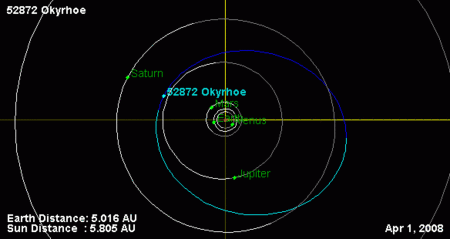52872 Okyrhoe
| Discovery | |
|---|---|
| Discovered by | Spacewatch |
| Discovery date | September 19, 1998 |
| Designations | |
| 1998 SG35 | |
| centaur[1][2][3] | |
| Orbital characteristics | |
| Epoch 2008-11-30 (2454800.5) | |
| Aphelion | 10.934 AU |
| Perihelion | 5.799 AU |
| 8.366 AU | |
| Eccentricity | 0.3068 |
| 24.20 yr | |
| 12.55 | |
| Inclination | 15.65 |
| 173.1 | |
| 338.0 | |
| Physical characteristics | |
| Dimensions | 49 km[4] |
| 8.3 h[5] | |
| Albedo | 0.03[6] |
| 10.8[1] | |
|
| |
52872 Okyrhoe (/əˈkɪroʊ.iː/; from Greek: Ωκυρόη, Ωκυρρόη) is a centaur orbiting in the outer Solar System between Jupiter and Saturn. It was discovered on September 19, 1998, by Spacewatch.
Orbit
Centaurs have short dynamical lives due to strong interactions with the giant planets. Okyrhoe (1998 SG35) is estimated to have an orbital half-life of about 670 kiloannum.[7]
Of objects listed as a centaur by the Minor Planet Center (MPC),[3] JPL,[1] and the Deep Ecliptic Survey (DES),[2] Okyrhoe has the second smallest perihelion distance of a numbered centaur. Numbered centaur (315898) 2008 QD4 has a smaller perihelion distance.

Sublimation
Okyrhoe passed perihelion in early 2008,[1] and exhibited important magnitude variations during March and April 2008.[8] This could be a sign of sublimation of volatiles.
Name
It was named after Ocyrhoe, Greek mythology.
References
- ↑ 1.0 1.1 1.2 1.3 "JPL Small-Body Database Browser: 52872 Okyrhoe (1998 SG35)" (last observation: 2008-06-06). Retrieved 2008-10-11.
- ↑ 2.0 2.1 Marc W. Buie. "Orbit Fit and Astrometric record for 52872" (last observation: 2008-04-24). SwRI (Space Science Department). Retrieved 2008-10-11.
- ↑ 3.0 3.1 "List Of Centaurs and Scattered-Disk Objects". Minor Planet Center. Retrieved 2008-10-16.
- ↑ Wm. Robert Johnston (22 August 2008). "List of Known Trans-Neptunian Objects". Johnston's Archive. Retrieved 2012-05-10.
- ↑ Bauer, J. M.; Meech, K. J.; Fernandez, Y. R.; Pittichova, J.; Hainaut, O. R.; Boehnhardt, H.; Delsanti, A. C. (2003). "Physical Survey of 24 Centaurs with Visible Photometry". Icarus 166 (1): 195–211. Bibcode:2003Icar..166..195B. doi:10.1016/j.icarus.2003.07.004.
- ↑ E. Dotto, M.A. Barucci, C. de Bergh. "Colours and composition of the Centaurs". Osservatorio Astronomico di Roma, Italy. Retrieved 2008-10-19. (word format)
- ↑ Horner, J.; Evans, N.W.; Bailey, M. E. (2004). "Simulations of the Population of Centaurs I: The Bulk Statistics". Monthly Notices of the Royal Astronomical Society 354 (3): 798. arXiv:astro-ph/0407400. Bibcode:2004MNRAS.354..798H. doi:10.1111/j.1365-2966.2004.08240.x.
- ↑ Trigo-Rodríguez, Melendo, García-Hernández, Davidsson, Sánchez (2008). "A continuous follow-up of Centaurs, and dormant comets: looking for cometary activity." (PDF). European Planetary Science Congress. Retrieved 2008-10-12.
External links
- Orbital simulation from JPL (Java) / Ephemeris
| ||||||
| ||||||||||||||||||||||||||||